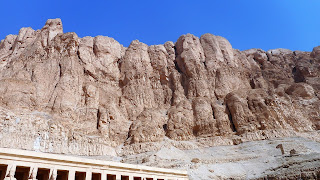The Mortuary Temple of Hatshepsut, also known as the Djeser-Djeseru – “Holly of Holies” is an ancient funerary shrine in Upper Egypt. Dedicated to the Pharaoh Hatshepsut, is located beneath the cliffs at Deir el Bahary, on the west bank of the Nile near the Valley of the Kings. The mortuary Temple is dedicated to the sun god Amun and is situated next to the mortuary temple of Mentuhotep II, which served both as an inspiration and later, a quarry. It is considered one of the “incomparable monuments of ancient Egypt.” After long description of the Temple our guide Mr.Rajab Alazar took us photos in front of the staircase, and when we climbed it up. On second floor we were met by local guides who wanted to explain more and mostly take photos with us with their Muslim hats. Everybody of them took his baksheesh! Al photos are shown in this album.

























































































